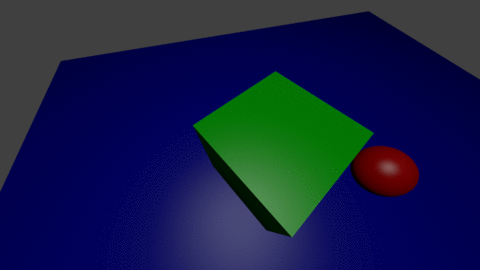Creating animation in Blender using Python
This code was created as my final project on Computer Graphics in 2015 at FJFI CVUT in Prague. It describes creating simple scene, adding lights and cameras and creating simple animation.

import bpy
from mathutils import Vector
# useful shortcut
scene = bpy.context.scene
# this shows you all objects in scene
scene.objects.keys()
# when you start default Blender project, first object in scene is a Cube
kostka = scene.objects[0]
# you can change location of object simply by setting the values
kostka.location = (1,2,0)
# same with rotation
kostka.rotation_euler = (45,0,0)
# this will make object cease from current scene
scene.objects.unlink(kostka)
# clear everything for now
scene.camera = None
for obj in scene.objects:
scene.objects.unlink(obj)
# create sphere and make it smooth
bpy.ops.mesh.primitive_uv_sphere_add(location = (2,1,2), size=0.5)
bpy.ops.object.shade_smooth()
kule = bpy.context.object
# create new cube
bpy.ops.mesh.primitive_cube_add(location = (-2,1,2))
kostka = bpy.context.object
# create plane
bpy.ops.mesh.primitive_plane_add(location=(0,0,0))
plane = bpy.context.object
plane.dimensions = (20,20,0)
# for every object add material - here represented just as color
for col, ob in zip([(1, 0, 0), (0,1,0), (0,0,1)], [kule, kostka, plane]):
mat = bpy.data.materials.new("mat_" + str(ob.name))
mat.diffuse_color = col
ob.data.materials.append(mat)
# now add some light
lamp_data = bpy.data.lamps.new(name="lampa", type='POINT')
lamp_object = bpy.data.objects.new(name="Lampicka", object_data=lamp_data)
scene.objects.link(lamp_object)
lamp_object.location = (-3, 0, 12)
# and now set the camera
cam_data = bpy.data.cameras.new(name="cam")
cam_ob = bpy.data.objects.new(name="Kamerka", object_data=cam_data)
scene.objects.link(cam_ob)
cam_ob.location = (-3, 0, 5)
cam_ob.rotation_euler = (3.14/6,0,-0.3)
cam = bpy.data.cameras[cam_data.name]
cam.lens = 10
### animation
positions = (0,0,2),(0,1,2),(3,2,1),(3,4,1),(1,2,1)
# start with frame 0
number_of_frame = 0
for pozice in positions:
# now we will describe frame with number $number_of_frame
scene.frame_set(number_of_frame)
# set new location for sphere $kule and new rotation for cube $kostka
kule.location = pozice
kule.keyframe_insert(data_path="location", index=-1)
kostka.rotation_euler = pozice
kostka.keyframe_insert(data_path="rotation_euler", index=-1)
# move next 10 frames forward - Blender will figure out what to do between this time
number_of_frame += 10